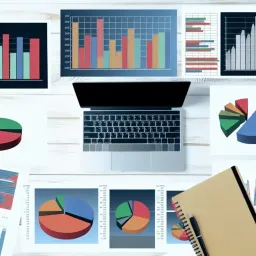
- Templates
- Svetlana Cheusheva
Are you looking to transform your data into visually compelling insights? Heat maps might just be the tool you need! These graphical representations not only enhance your data presentations but also simplify complex information. Let’s explore the key lessons that will empower you to harness the power of heat maps in your data visualization efforts.
Heat maps serve various purposes across industries, enabling quick insights and aiding in decision-making. Below are key aspects highlighted in the article, including essential Excel data analysis tips.
Allows users to grasp complex datasets at a glance.
Helps identify trends and outliers effectively.
Visualizing data allows for better, data-driven decisions.
Heat maps are a powerful tool in data visualization that can transform raw data into something visually appealing and easy to understand. They use color gradients to represent data values, allowing you to quickly identify patterns and insights. As the founder of Sheet Nerds, I've seen firsthand how heat maps can make complex data more accessible!
By utilizing heat maps, you not only enhance the aesthetic appeal of your data presentations but also improve the ability to analyze trends effectively. This is vital for anyone looking to make informed decisions based on data. So, let’s dive deeper into what heat maps are and how they can benefit you! If you're interested in learning more about data analysis techniques, check out this post on data analysis techniques.
Heat maps are graphical representations of data where individual values are represented by colors. They are widely used across various industries to display data in an intuitive format. Here are some key reasons you might want to use heat maps:
When you apply heat maps in Excel, you're taking your data visualization game to the next level! They can be particularly useful for tracking performance metrics, sales data, and more.
Heat maps excel at showing trends that might be hidden in traditional tables or charts. By representing data values through colors, you can easily spot areas that need attention. This visual approach is beneficial for:
In my experience with Sheet Nerds, using heat maps has helped me and others uncover insights that were previously obscured by raw data. It’s amazing how a simple color change can reveal so much!
The insights gained from heat maps are invaluable. They can lead to actionable strategies that can improve business outcomes. Here are some specific insights you can gain:
Using heat maps in Excel, I’ve witnessed firsthand how they can drive discussions and lead to innovative solutions. They empower teams to visualize problems and opportunities in a way that data tables simply cannot!
Did you know? Using a diverging color scale for your heat maps can help emphasize the differences in data values more clearly. This is especially useful when you want to highlight both high and low values simultaneously, making it easier for your audience to interpret the data's significance.
As we dive deeper into the world of heat maps, it's normal to have questions, especially if you're just starting. With my experience in mastering Microsoft Excel, I've seen many users face similar challenges when creating heat maps. In this section, I’ll address some frequent questions and provide practical tips to enhance your understanding and skills.
Here are some common questions that often arise when working with heat maps:
When using heat maps, beginners may encounter a few issues. Understanding these can save you time and frustration. Common problems include incorrectly formatted data, which can lead to misleading visualizations, or not applying conditional formatting correctly. Here are some quick tips to help troubleshoot:
Don't hesitate to reach out for help if you're stuck! Resources like Sheet Nerds provide excellent guidance for troubleshooting.
To truly master heat maps and data visualization in Excel, it’s essential to keep learning. Here are some resources that can deepen your understanding:
These resources can provide you with new techniques and insights to enhance your skills!
Excel is a fantastic tool for creating heat maps, but there are other software options that can complement your visual storytelling. Some popular tools include:
Each tool has its strengths, so I encourage you to explore them and find what works best for your needs!
In this section, we’ve explored the importance of addressing common questions related to heat maps. Remember, troubleshooting and continuous learning are crucial as you enhance your data visualization skills. With the right resources and tools, you can take your heat map creations to the next level!
Let’s recap the essential steps for creating effective heat maps in Excel:
By following these steps, you can ensure your heat maps are both informative and visually appealing!
Data visualization is an ever-evolving field, and there's always something new to learn! I encourage you to stay curious and keep exploring different techniques. Engaging with communities, attending webinars, or simply practicing regularly can provide you with fresh insights and tips.
Are you ready to dive into your first heat map creation? Remember, Sheet Nerds is here to support you every step of the way! Start experimenting with your data and see how heat maps can illuminate trends and insights that were previously hidden. Happy mapping!
Here is a quick recap of the important points discussed in the article:
